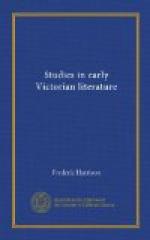This sympathy with nature, and this power to invest it with feeling for the human drama of which it is the scene, lifts little Charlotte Bronte into the company of the poets. No one, however, can enter into all the art of her landscapes unless he knows those Yorkshire moors, the straggling upland villages, bare, cold, gray, uncanny, with low, unlovely stone buildings, and stern church towers and graveyards, varied with brawling brooks and wooded glens, and here and there a grim manor-house that had seen war. It is so often that the dwellers in the least picturesque and smiling countries are found to love their native country best and to invest it with the most enduring art. And the pilgrims to Haworth Parsonage have in times past been as ardent as those who flock to Grasmere or to Abbotsford.
Jane Eyre is full of this “pathetic fallacy,” or aspect of nature dyed in the human emotions of which it is the mute witness. The storm in the garden at night when Rochester first offers marriage to his little governess, and they return to the house drenched in rain and melted with joy, is a fine example of this power. From first to last, the correspondence between the local scene and the human drama is a distinctive mark in Jane Eyre.
If I were asked to choose that scene in the whole tale which impresses itself most on my memory, I should turn to the thirty-sixth chapter when Jane comes back to have a look at Thornfield Hall, peeps on the battlemented mansion which she had loved so well, and is struck dumb to find it burnt out to a mere skeleton—“I looked with timorous joy toward a stately house: I saw a blackened ruin.” The suddenness of this shock, its unexpected and yet natural catastrophe, its mysterious imagery of the loves of Edward Rochester and Jane Eyre, and the intense sympathy which earth, wood, rookery, and ruin seem to feel for the girl’s eagerness, amazement, and horror, have always seemed to me to reach the highest note of art in romance. It is now forty-seven years since I first read that piece; and in all these years I have found no single scene in later fiction which is so vividly and indelibly burnt into the memory as is this. The whole of this chapter, and what follows it, is intensely real and true. And the very denoument of the tale itself—that inevitable bathos into which the romance so often dribbles out its last inglorious breath—has a manliness and sincerity of its own: “the sky is no longer a blank to him—the earth no longer a void.”
The famous scene in the twenty-sixth chapter with the interrupted marriage, when Rochester drags the whole bridal party into the den of his maniacal wife, the wild struggle with the mad woman, the despair of Jane—all this is as powerful as anything whatever in English fiction. It is even a masterpiece of ingenious construction and dramatic action. It is difficult to form a cool estimate of a piece so intense, so vivid, and so artful in its mechanism.




